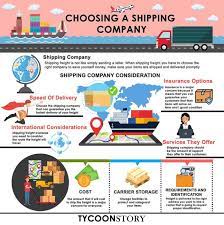What Should You Consider When Choosing Your Shipping Carrier
When you’re shopping for a shipping carrier, there are a few things to consider. First and foremost, what type of service do you need? Do you need your items delivered quickly and efficiently, or do you want to save money on your shipping bill? Second, what kind of price range are you comfortable with? Are you looking for the cheapest option or the most affordable one? Finally, what is your shipping destination? Do you need your items delivered directly to your door, or will they first need to be sent to a warehouse before being shipped out?
Each of these factors can impact how much you will pay for shipping and how quickly your items will arrive. For example, if your item needs to be delivered quickly and doesn’t require any packaging, then choosing an express shipping option may be more expensive than a standard shipping option but it will likely arrive sooner. On the other hand, if your item requires heavy packaging or needs to be shipped internationally, then choosing a standard shipping option may be cheaper but it may take longer to arrive.
No matter which type of shipping carrier you choose, make sure that you are aware of all the costs involved so that you can compare prices and decide which option is best for you. There are a variety of carriers available online so don’t hesitate to explore them all!
e-commerce logistics Canada
eCommerce logistics can be a complex and daunting task. It’s important to choose the right shipping carrier, account manager, and shipping provider to ensure your products make it to your customers in a timely and reliable manner. Here are some key considerations to make when choosing eCommerce logistics:
Shipping Carrier:
There are a number of different shipping carriers available for online retailers, each with their own advantages and disadvantages. Some common shipping carriers include UPS, FedEx, and DHL. It’s important to research the different options available and choose the one that will provide the best overall service for your business.
Account Management:
It’s also important to choose an account management company that can help you track your shipments and manage your billing cycle. Many account managers offer eCommerce shipping services as well as other marketing and sales functions. Choose an account manager that specializes in eCommerce logistics so you can be sure they have the knowledge and resources necessary to help you succeed.
Shipping Provider:
Finally, it’s important to select a shipping provider that has the infrastructure in place to support your eCommerce business. Many shippers offer customized shipping solutions that allow you to streamline your process. Choose a shipping provider that offers both quick delivery times and reliable service.
first-mile shipping
When you’re choosing a shipping carrier, there are a few things to consider. Here are four tips to help you choose the right one for your first mile shipping needs:
1. Size Matters
When it comes to size, don’t just look at the size of the carrier itself. Also, consider how much cargo the carrier can hold and how durable the cargo containers are.
2. Location, Location, Location

Consider where you’ll be shipping your goods and what infrastructure is available nearby. Will you need to transport your cargo over water, through mountains, or through another difficult terrain? Those considerations will affect which carrier is best suited for your needs.
3. Price Point Matters Too
Just because a carrier is large doesn’t mean it’s the best option for your shipment. You also have to consider the price point and whether you can afford the cost of using that carrier.
4. Safety First!
Make sure you pick a carrier that has a good safety record and is licensed by government agencies like DOT and ISO. This will ensure that your shipments arrive safely and without any issues along the way.
shipping electronics internationally
When shipping electronics internationally, consider the following factors:
-Size and weight of your package
-Distance your package will travel
-Quality of packaging
-Cost of shipping
-Ease of tracking your package
-Time required for delivery
To determine the size and weight of your electronics shipment, first, calculate the dimensions and weight of each item. Add these figures together to get an approximate total weight and size of your shipment. Then compare this total weight and size to the recommended maximum allowable weight and size for your shipping carrier. If the package exceeds this limit, you may have to pay additional freight charges or select a different shipping carrier.
If you’re sending a large item that will need to be shipped in several boxes, you can break it down into smaller shipments and ship them as individual packages. This will reduce the overall size and weight of your shipment, making it easier to send through the mail.
When shipping electronics internationally, keep in mind that distances vary greatly around the world. The distance from your city to a destination in Europe is much shorter than the distance from Los Angeles to Beijing. As a result, packages traveling via air can take considerably longer than packages traveling over land or water. When calculating delivery time, take into account both the transit time from the origin to the final destination as well as the time required for customs clearance.
For more information on shipping electronics internationally, please visit our website or contact one of our customer services
When choosing a shipping carrier, be sure to consider the costs and delivery times.
While UPS and FedEx are the most popular shipping carriers, they may not always be the best option. Sometimes, it makes more sense to use a less well-known carrier, or even to ship your package yourself.
The most important thing is to choose a carrier that will get your package to its destination on time and without any damage. Be sure to compare rates and delivery times before making your final decision.
Choose a carrier with a good track record for shipping electronics.
When you are looking for a carrier to ship your electronics, it is important to choose one with a good track record. There are many carriers out there, but not all of them have a good reputation for shipping electronics. Some carriers are known for losing or damaging items, so it is important to do your research before choosing one.
There are a few ways to find out if a carrier has a good track record for shipping electronics. One way is to ask around and see if anyone you know has used that particular carrier before. Another way is to read online reviews from other customers who have used the carrier. Finally, you can contact the carrier directly and ask about their policies and procedures for shipping electronics.
If you take the time to choose a reputable and reliable carrier, you can rest assured that your electronics will arrive safely at their destination.
Compare the delivery times and costs of different carriers.
There are many factors to consider when choosing a delivery carrier. Cost and delivery time are two of the most important. Comparing the cost and delivery time of different carriers can help you make the best decision for your needs.
The United States Postal Service (USPS) is often the cheapest option for small packages. However, their delivery times can be slow, especially for cross-country shipping. UPS and FedEx are generally more expensive than USPS, but they offer faster delivery times.
When comparing carriers, be sure to consider all costs, including shipping and handling charges. You should also compare transit times to ensure that your package will arrive when you need it.
Check out reviews of the carriers to find the best option for your needs.
Most people choose a carrier based on personal preference, but it’s important to do your research to find the best option for you. Check out online reviews of carriers to get an idea of what others think about their service. You can also ask friends and family for recommendations. Once you’ve narrowed down your choices, compare prices and plans to find the best deal.
